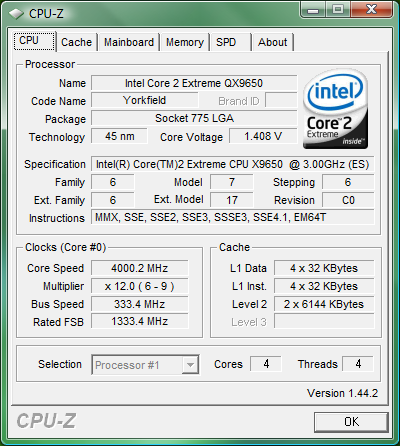Page 9 - Benchmark: SuperPI 1M; Overclocking
About SuperPI
Super PI is a computer program that calculates pi to a specified number of digits after the decimal point - up to a maximum of 32 million. It uses FFT arithmetic and Borwein's quartically-convergent algorithm and is a Windows port of the program used by Yasumasa Kanada in 1995 to compute Pi to 232 digits. Super PI uses x87 floating-point unit, so it favors processors with good FPU performance, such as AMD Athlon 64 and Intel Core 2.
From: Wikipedia (March 14, 2007)

SuperPI is a single threaded benchmark, so we can once again see the independent core performance of each processor compared. The QX9650 finished calculating to one million digits of Pi in 15.563 seconds, a total of 4.156 seconds faster than the Penryn E7200 CPU.
Now, onto everyone's favorite part -- overclocking. To be honest, I wouldn't expect the Core 2 Extreme QX9650 to be a great overclocker in terms of percentage, simply because it's already clocked very high out of the box. But to fuel your curiosity, let's see what we can do.
We overclocked by changing the upwards unlocked multiplier to make sure nothing else gets in the way, such as motherboard limitations.

I wasn't able to get anything significant until I reached 1.3750V setting on my motherboard, which got me a decent 3.67GHz final clock speed at 11x multiplier. This translates to a somewhat decent 22% overclock at a very safe voltage range.

I tried to increase the multiplier by another 0.5 to 11.5x, and the lowest stable voltage dramatically increased to 1.4250V setting on my motherboard. At 3.83GHz, this makes it a 28% clock increase from stock.

Finally, at 1.4500V I was able to bring the QX9650 to an impressive raw clock speed of 4.0GHz -- yes, a 4.0GHz Yorkfield CPU. It's "only" 33% over stock, but at this point, it's certainly a sizzling fast processor.
We did not bring the voltage beyond 1.4500V to stay within a reasonable range on these Penryn processors.
Page Index
1. Introduction and Specifications
2. Intel QX9650 Architecture; Test System
3. Benchmark: EVEREST CPU
4. Benchmark: EVEREST FPU
5. Benchmark: PCMark05
6. Benchmark: 3DMark06
7. Benchmark: Cinebench R10
8. Benchmark: SYSMark 2007
9. Benchmark: SuperPI 1M; Overclocking
10. Power Consumption and Conclusion





